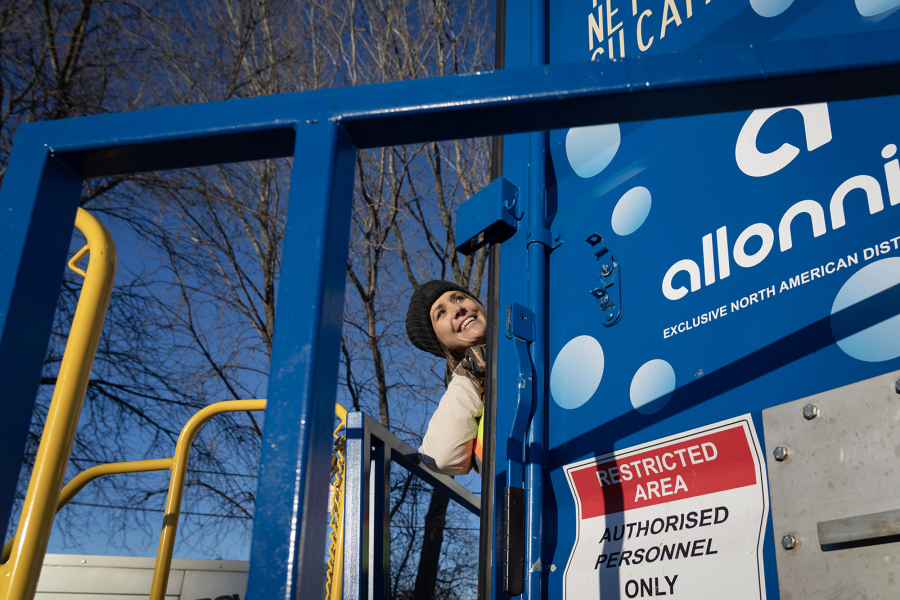The bright blue shipping container stood out in the snow-covered landscape of Tablyn Park in Lake Elmo, Minnesota. Inside, contractors calibrated a machine that state officials hope could help solve a decades-long pollution problem in the east metro area.
Within the trailer, groundwater will be pumped into large black drums that are topped with clear blue cylinders. Air will be injected into the water to create bubbles — and in the upper chambers, the machine will collect a foam that’s brimming with toxic chemicals collectively known as PFAS. The decontaminated water will then be pumped back underground.
“The hope here is that we are able to reduce the spread of PFAS, so that we can reduce the number of necessary treatment options on wells,” said Rebecca Higgins, a senior hydrogeologist for the Minnesota Pollution Control Agency. “It’s protecting this groundwater resource for current and future generations.”
Minnesota has spent millions filtering the drinking water in communities where PFAS lingers in the groundwater. This new effort is meant to remove the industrial chemicals from the environment.
At full power, the surface activated foam fractionation, or SAFF, system should be able to process 60,000 gallons of water a day, Higgins said. The processing would strip out 5 gallons of a concentrated chemical soup, which will be analyzed by scientists looking for 40 different formulations of PFAS.
PFAS, or per- and polyfluorinated substances, were pioneered by Maplewood-based 3M in the 1950s. They are used widely to suppress fires, repel water, fend off stains and make nonstick cookware. But the same carbon-fluorine bonds that make the compounds useful also make them extremely difficult to destroy, earning them the name “forever chemicals.”
Research linked some of the PFAS chemicals to kidney cancer, reduced immune responses, low birth weights and changes in the liver, according to the MPCA.
Pollution problems in the east metro have been well-known for years. PFAS leached out of dumps 3M used for its Cottage Grove chemical plant and was found in drinking water in Lake Elmo, Woodbury, Oakdale and Cottage Grove through the early 2000s. The chemicals are still popping up in unexpected places around the east metro from time to time — such as the discovery two years ago that they had concentrated in foam along two creeks.
As it turns out, that foam is part of the inspiration for the new technology being tested by the MPCA now. PFAS lingers on the surface of water, and much like a soap, it tends to form bubbles.
“Why not exploit that same principle and try to use it to our advantage, right, to try to physically remove it?” Higgins said.
The SAFF system was purchased this year for $790,000. The funds come from an $850 million settlement that Minnesota struck with 3M in 2018 after suing over environmental contamination.
Much of that money has gone to drinking water treatment. But Matt Simcik, a professor of environmental chemistry at the University of Minnesota, said he was thankful that environmental contamination isn’t being forgotten in the state’s efforts.
“They’re a hazard in the environment and they don’t go away, and we’ve got some of the highest concentrations measured in the groundwater in the east metro,” Simcik said. “So we need to do something.”
Researchers working on new technology face a global problem in containing PFAS. The chemicals have been found in animals across the planet, including in the bodies of polar bears.
In the United States, the scope of contamination sources is still being uncovered. 3M and Dupont, another PFAS manufacturer, face significant liability from a PFAS-laced firefighting foam that was widely used at airports and military installations to put out dangerous fuel fires. Near another 3M chemical plant in Illinois, north of the Quad Cities, the EPA recently ordered the company to test and treat drinking water for thousands of people.
Simcik has studied the compounds for years and is working on an alternate option for containment: a coagulant that would stick to the PFAS molecules and block them from moving through groundwater and into drinking water.
Simcik said containment has the benefit of being low-maintenance, but questions remain about how long the strategy works. Systems like the SAFF machinery are better in that they actually remove the chemicals from the environment — but they require more money and personnel to run.
All of these different strategies need more field testing, however. “We’re kind of in the infancy of this, learning these technologies and developing these technologies,” Simcik said.
Higgins said the state does not yet know how much it will cost to operate the SAFF system. The MPCA plans to keep the unit at its current location for five to six months, and then will test it in other areas with known pollution.
The agency will also test another technology that hasn’t yet arrived, called De-Fluoro. It is designed to break apart the notoriously strong PFAS molecules by combining them with oxygen through an electrical charge. The MPCA hasn’t bought the system, but is borrowing it from contractor AECOM.
Higgins said the state will have to test De-Fluoro carefully, and that it may not be able to destroy the chemicals entirely.
“You can’t over-promise and under-deliver,” she said. “That’s just one of many technologies we hope to try.”



